Photoshop vs GIMP
Photoshop or GIMP? Which software is right for you in 2022?
We’ve tested both programs extensively. Read this detailed Photoshop vs. GIMP comparison to see which one works for you.
GIMP is a free, open-source image editor that’s been around twenty years. It was created by a group of volunteers worldwide, dedicated to creating a powerful and free image editor. Volunteers continuously edit the software, and new updates appear regularly to fix software bugs.
Adobe Photoshop is a raster-based photo editing program that has been around since 1987. The software is the professional standard for graphic designers and creators. The program’s capabilities are vast and include illustration, animation, 3-D, photo-retouching, and more.
Comparison At a Glance
1. Features
Winner: Adobe Photoshop. Adobe Photoshop has more features than GIMP. GIMP is great for general photo editing. Photoshop takes the software one step further, giving you ultimate precision over your photos and the ability to create a variety of art.
2. Pricing
Winner: GIMP. GIMP is free software, unlike subscription-based Photoshop. Per the founders, GIMP was founded as free software and will always be free software. Enough said.
3. User Interface
Winner: Adobe Photoshop. GIMP is not as cleanly organized as Photoshop. While the focus on photo editing makes GIMP more intuitive, Photoshop organizes the tools in the best way.
4. Support/Updates
Winner: Adobe Photoshop. Overall, Adobe Photoshop has more consistent updates with new features/bug fixes and a better support system. Meanwhile, GIMP still has many resources. Both have communities and forums to help support users.
5.Compatibility
Winner: GIMP. This software works on Linux, OS X, and Windows. It also lets users use the older versions of the software, unlike Adobe’s limited agreement. Overall, Gimp is the most compatible.
6. Users
Winner: Tie. Both Photoshop and GIMP are powerful editing programs with different uses. If you are a small business or hobbyist who needs a simple editing software, GIMP makes sense for you. If you want to work in the professional creative industry, Photoshop is the industry standard and a clear choice. It entirely depends on why you need the software.
7. Learning Curve
Winner: Tie. Photoshop is hard to learn because of the sheer amount of tools you need to go through to figure out the basics. GIMP is difficult because some of the most simple edits are not as intuitive.
Short Verdict
Photoshop is the industry-standard tool that can be used for everything from photo editing and graphic design to animation and digital painting. GIMP is a free image editing software that offers limited features and functionalities. Overall, Photoshop is the better program among the two.
1. Features
Overall, Photoshop has more capabilities than GIMP. While GIMP is a powerful program, Photoshop has more features, better UI, and a huge behind-the-scenes team that makes Photoshop one of the world’s most powerful programs.
In terms of photo-editing, both GIMP and Photoshop have all of the basic editing tools. If you need a basic edit, GIMP is all you need. However, Photoshop takes the precision one step further and has many advanced tools that GIMP doesn’t offer.
GIMP makes it so easy to create custom brushes, allowing the user a ton of flexibility. With a few saves, you can turn any image into a brush, adjusting brush size, tweaking how the pattern repeats, and more.
GIMP also allows the user to import most Photoshop brushes. Photoshop has tons of free brushes created by users over the years and brush sets sold in bundles. Many of these resources are either reasonably priced or free. There are tons of customizable options.
Photoshop has access to the ever-extensive Adobe Typekit and Adobe Stock. These online databases provide hundreds of font choices and images for your work. (Adobe Stock is an additional subscription add-on that you must pay for.) In GIMP, you can use free fonts downloaded from free databases online and utilize free stock image sites like Unsplash.
Photoshop can also create animation, 3D effects, and illustration. The software is great for painting. For example, designers will make a vector logo in Illustrator and then finish painting it in Photoshop. Photoshop offers dozens of brushes, including tools like blur and smudge, to make the painting process even more seamless.
You can also edit raw photos directly in Photoshop using Camera Raw. GIMP is limited. You have to convert the photographs before working with them in the program. Editing in raw is important for a photographer because it gives you the most creative control over a photo. When you can use all of the digital information captured from the sensor, you will have the most control over the image’s lighting and color.
Currently, GIMP does not support non-destructive editing Photoshop features such as smart objects or layer adjustment. Per the FAQ section on the website, the developers behind the software hope to get this feature in GIMP 3.2. They realize it will change the interface completely.
Smart objects and adjustment layers are some of the most powerful features of Photoshop. It allows users to import vector and raster files or Photos and transform the layer without losing the asset’s source content. Not having this in GIMP is a dealbreaker for some. There are workarounds, but it’s not quite as seamless as Photoshop.
GIMP does not fully support CMYK color mode. CMYK mode is essential for users who work with print-based media. GIMP only supports RGB, Grayscale, and Indexed. Meanwhile, Photoshop supports CMYK, RGB, Index, Grayscale, and Bitmap modes.
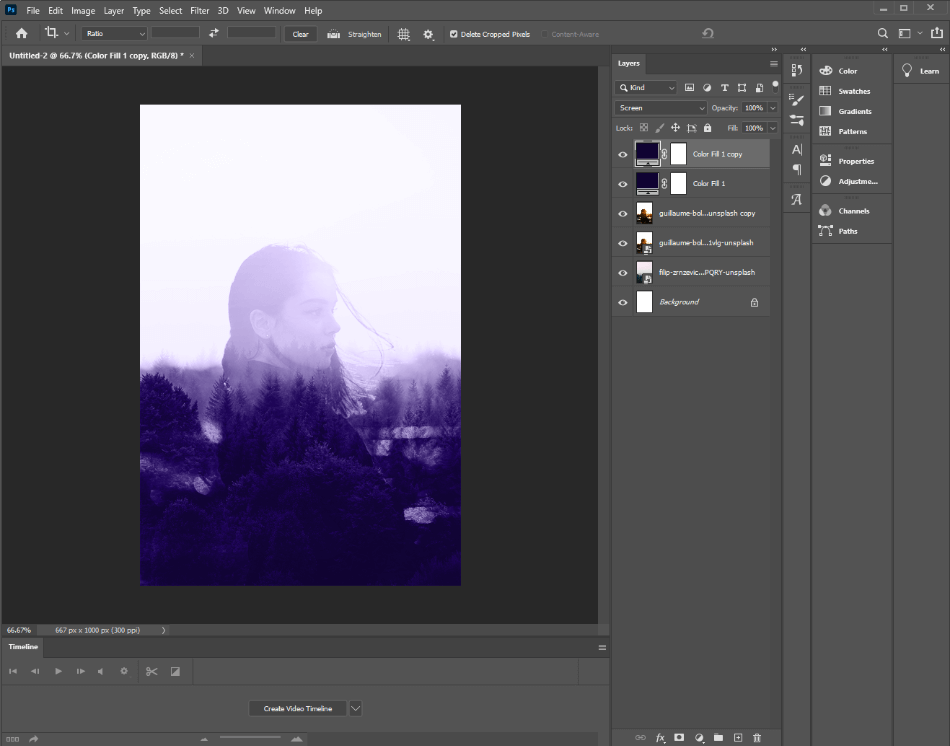
Both GIMP and Photoshop offer a ton of filters and special effects. Each program has its own unique set of filters with slightly different results for each. They don’t truly replace one another. It’s apples and oranges, really.
Photoshop also connects seamlessly with the other Adobe creative cloud applications, allowing the user to jump around different software to create a finished piece without leaving the Adobe family.
GIMP is limited to mainly photo editing. If you are trying to replace Adobe products with free alternatives, it is possible but will be a less user-friendly experience.
Overall, Photoshop offers more features in terms of software. GIMP is great as a free editing alternative, albeit with less editing power.
Winner: Adobe Photoshop
2. Pricing
| Product | Regular Price |
|---|---|
| Adobe Creative Cloud | $52.99/month |
| Adobe Photoshop | $20.99/month |
| GIMP | Free |
Of course, GIMP is the winner because it is free software. There is no beating this. Adobe Photoshop, on the other hand, is a subscription-only software.
To download GIMP, all you have to do is go to the download section on the website and download GIMP for your operating system. That’s it! There are no hidden fees.
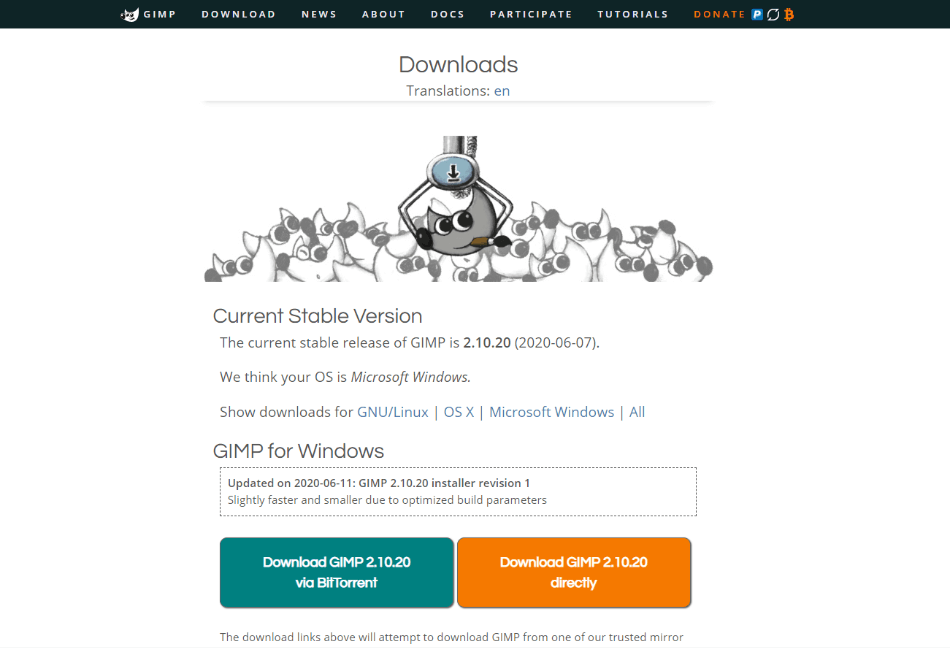
Meanwhile, you must pay for a Photoshop subscription. To get Photoshop:
- Pay $20.99/month or $251.88/year for the individual subscription. This package includes Adobe Fresco, Photoshop on desktop and iPad, and 100 GB of cloud storage.
- Pay $9.99/month or $119.88/year for the Photoshop and Lightroom bundle. You get both Adobe Photoshop and Lightroom for desktop and iPad, 20 GB cloud storage, and desktop-focused Lightroom classic in this subscription.
- Pay $52.99/month or $638.88/year for the full Creative Cloud Subscription. You get all of the Creative Cloud Applications plus 100 GB of cloud storage.
- Pay $19.99/month or $239.88/year for the full Creative Cloud Subscription if you are a current teacher or student. (You must prove current enrollment) You get all of the Creative Cloud applications plus 100 GB of cloud storage.
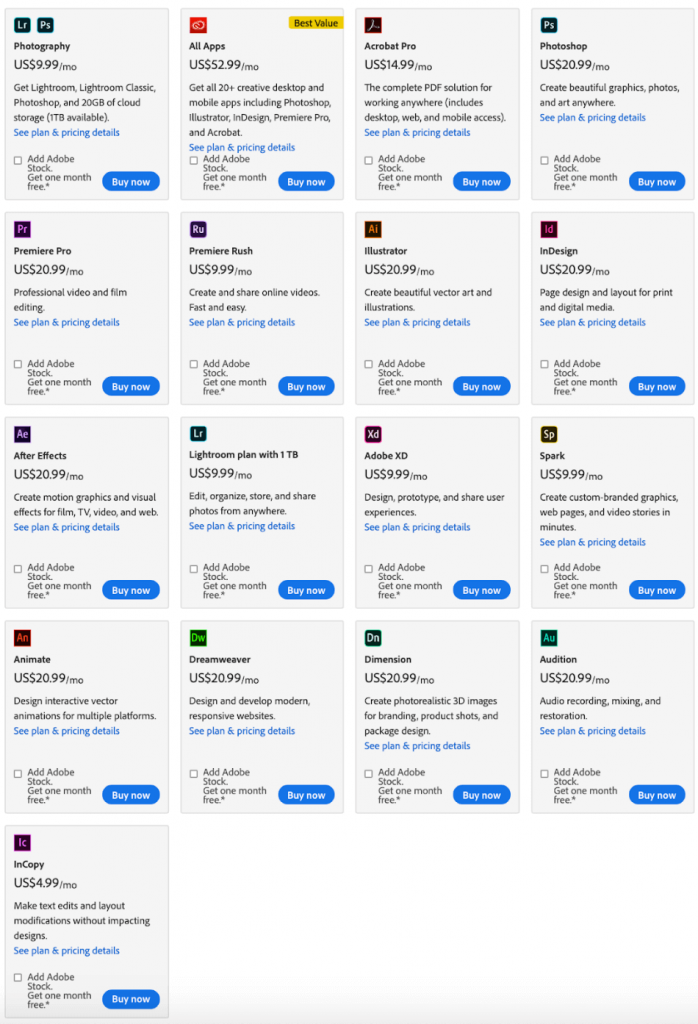
Also, these subscription prices are based on a year-long contract. You can pay month to month, but it can cost over 30% more monthly.
Clearly, GIMP is the winner.
3. User Interface
Photoshop has a much cleaner UI than GIMP. GIMP’s software is functional but not as good-looking or intuitive as Adobe Photoshop.
For example, importing an image off of my computer was much clunkier. Here is the GIMP interface:
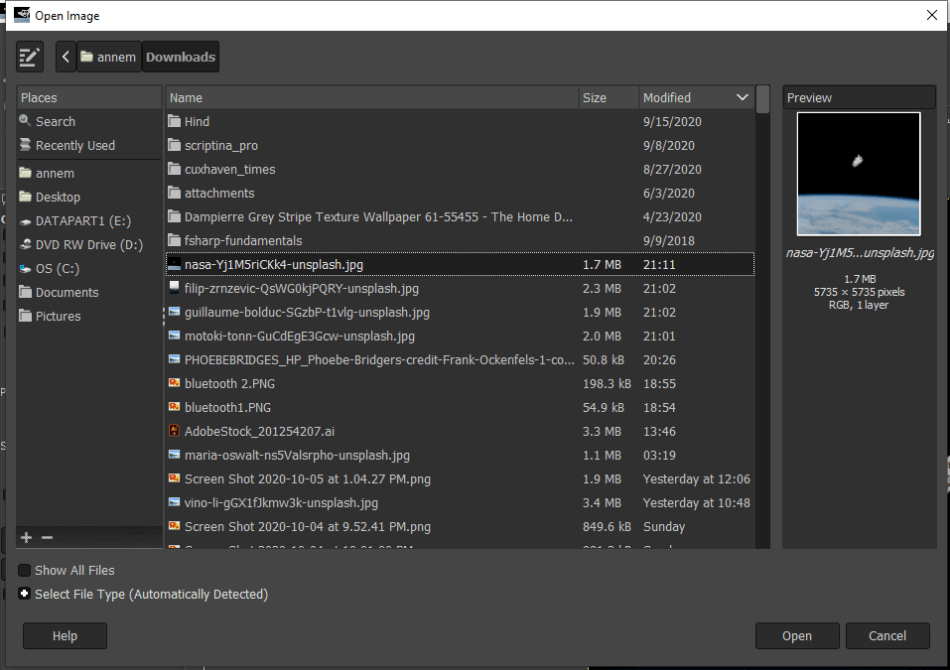
I had to hunt to find my files in GIMP. On the other hand, the Photoshop version is much cleaner, using the traditional windows interface to find your files:
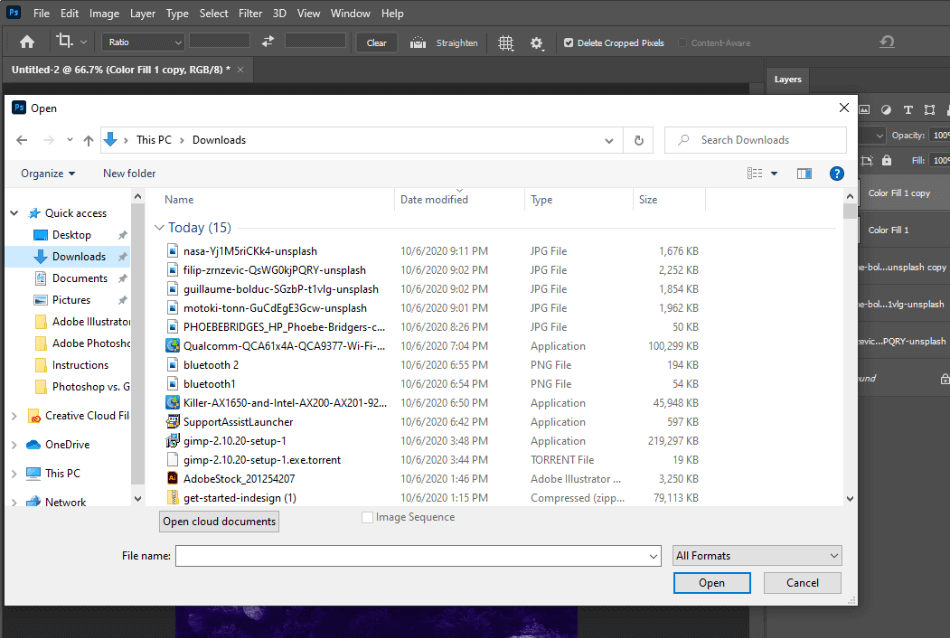
GIMP and Photoshop both have very customizable workspaces. You can move and hide GIMP and Photoshop windows, organizing your space, and streamlining your workflow.
The good things about the GIMP space are that there aren’t too many additional features, unlike Photoshop. In Photoshop, you can find yourself buried in many tools that you never use. Here, GIMP has the essentials. Perfect for concentrating on simple edits.
However, Photoshop utilizes more responsive tools, making the user interface more streamlined for the editor. For example, in GIMP, when I go to scale an image, I don’t see a preview of what I’m about to do. Photoshop shows you what your artwork will look like after the effects you are manipulating are applied. A more streamlined approach to applying an effect makes the editing process easier for the editor.
Overall, Photoshop provides a cleaner, more straightforward user experience.
4. Support/Updates
Adobe Photoshop has more regular updates than GIMP, issuing monthly updates to fix bugs and add new features. GIMP can go between three to four months before a new update, sometimes achieving new features, mostly focused on bug fixes.
Adobe also has 24/7 customer support via message and chat, resulting in quicker response to users’ problems. GIMP does not have this feature. You can contact them directly; however, they have noted on their website that they receive many emails and sometimes take a while to get back to you.
It’s worth noting that this particular comparison isn’t entirely on fairgrounds. Adobe Photoshop is a big business backed by huge financial resources, the Adobe company being a for-profit company. They also employ over 20,000 people. Meanwhile, GIMP is a non-profit initiative that was created and is still run by volunteers.
With that being said, GIMP still has a ton of resources. Both GIMP and Photoshop have an extremely active community. Tutorials for both GIMP and Photoshop are available on teaching platforms like Skillshare and free on YouTube.
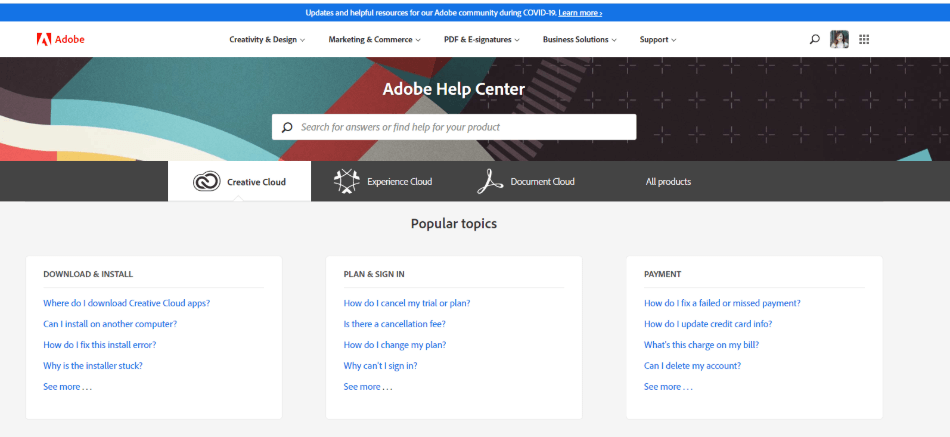
Both GIMP and Photoshop have extensive community forums where people discuss and solve problems. Photoshop has many lessons available right on their website. GIMP has a downloadable handbook that details the software in full and tutorials available on their site.
Overall, Photoshop has a more robust update and support system. Meanwhile, GIMP still has many resources to help teach you the software.
5. Compatibility
GIMP is available across Windows, OS X, and Linux. Photoshop is just available for Windows and OS X. While you could run a Windows virtual machine to run Photoshop on your Linux computer, it just does not work quite as well as running it directly on your computer.
GIMP also lets users use older versions of the software. There are no limitations to this. You can also customize the software for yourself as you see fit. Adobe, however, has discontinued applications and older versions of their software.
Photoshop works seamlessly with the Creative Cloud family. Users also get access to Adobe Stock and Typekit to get stock images and hundreds of fonts. There is also Photoshop for the iPad as well. GIMP has an adapted application called XGIMP for tablets.
Photoshop also requires a computer with high processing power. 8 GB of RAM is recommended, along with a powerful newer graphic card. The better your system, the smoother Photoshop and other Adobe applications will run. Overall, GIMP is less demanding than Photoshop.
Overall, GIMP is available for more operating systems. The software also lets you use older versions, making it more flexible with compatibility than Photoshop.
6. Users
Creative professionals use Photoshop because it is the industry standard and offers more capability. Hobbyists, beginners, or professionals use GIMP who mostly need photo-editing software for online viewing or are trying to stay on budget.
Photoshop is a requirement for many creative professionals. Businesses have to choose software for their company. Creative Cloud is simply one of the best collections of programs out there right now, especially for a team dynamic. Using a standard like Photoshop makes sense in terms of collaboration between Adobe programs and other creatives.
GIMP cannot be used in any print-based industry because of its lack of CMYK support, a dealbreaker for creatives. To be able to print colors accurately, the image needs to be edited or converted to CMYK. Not converting risks the colors coming out duller or darker than originally intended.
However, if the user is only working in the digital space and needs photos for their website/blog, GIMP can be a better option. It’s free software, and RGB mode is perfect for online viewing. If you are a hobbyist or small business looking for photo editing software to post on social media, GIMP is the perfect software for you.
Picking between GIMP and Photoshop is entirely dependent on what you are using it for.
7. Learning Curve
Photoshop and GIMP have their strengths and weaknesses when it comes to learning the software. While Photoshop is much more feature-packed, leaving the user overwhelmed, the layout is more intuitive, making it easier to learn. On the flip side, GIMP has fewer tools to master, so there is less to learn.
For many people, Photoshop will contain a lot of tools that you never use. While it’s great to have extra tools in the toolbox, sometimes this gets in the way of learning the software and getting your project done. The learning curve is generally steep for Photoshop just because of the sheer number of tools you need to master.
GIMP, likewise, isn’t as intuitive. While there are fewer tools to learn, the UI is clunkier and sometimes harder to follow. A tool that is very simple and straightforward in Photoshop can be obtuse and hard to use in GIMP.
Both GIMP and Photoshop offer many tutorials to learn the software. Also, there are many tutorials offered online, either free on YouTube or paid through Skillshare or Lynda.com, that can teach you the ins and outs of either software.
Final Thoughts
Photoshop and GIMP are both very powerful programs. Deciding which program works for you depends on your creative.
Beginners looking not to spend money should try GIMP before investing financially in Photoshop. You will learn general photo editing techniques without breaking the bank. If you want to move into something that is Industry-standard, you can upgrade to Photoshop.
Photoshop is an amazing program for professionals. The possibilities with the program are practically endless, and it integrates seamlessly with other Adobe software. If you want to work in the creative industry professionally, Photoshop is a good fit. Adobe offers reasonable-ish free trials to let you dip your toe in before investing way too much.
Overall, Photoshop offers more in terms of features. However, I recommend downloading GIMP and trying it for yourself. After all, it’s free. You may not need an expensive Adobe subscription, after all.